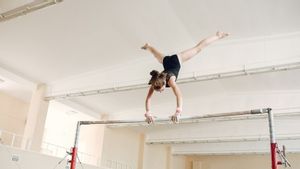JAKARTA - Commemoration of International Holocaust Day in memory of those who died as a result of Nazi atrocities, is usually centered at the Auschwitz-Birkenau Concentration Camp, Poland. This was the largest Nazi death camp and the most famous.
This year, the 76th anniversary of the liberation of Camp Auschwitz every January 27 is held virtually. Apart from these camps, many locations and monuments were made to commemorate Nazi atrocities scattered throughout Europe. Here are 5 locations in between, as reported by CNN:
Memorial to the Murdered Jews of Europe
First opened in 2005, the Monument to the Murdered European Jews stands close to Berlin's Brandenburg Gate
The corrugated design of 2,711 concrete slabs - all varying sizes - can create a sense of disorientation. The idea is to open a discussion about why. For some visitors it mimics the way the world was turned upside down during the Holocaust. The constantly changing levels under your feet, coupled with the direction of the trail that changes direction frequently, are meant to reflect the feeling of dislocation associated with the events of 1941-1945.
The gray slabs, of grave stature, were in a grid formation so that people could walk between them. Open day and night, offering the opportunity for quiet contemplation in the heart of the city.
The Wall of Names at the Shoah Memorial
Located in the historic Marais district in Paris, the Shoah Memorial is a wall engraved with the names of 76,000 Jews deported from France during the Nazi regime. Only 2,500 of those who were sent survived.
The concept of this wall is 'understanding the past to illuminate the future'. It was Europe's first Holocaust archive when it opened to the public in 2005. The site often hosts exhibitions commemorating genocide from the 20th century.
Beyond the memorial, the Wall of Righteous names the nearly 4,000 men and women who protected Jews between 1942 and 1944.
Shoes on the Danube Promenade
Perhaps one of the most visually striking memorial installations of the Holocaust is the Shoes on the Daube Promenade in Budapest, Hungary.
These traces of iron art represent thousands of people who were executed along the riverbank during the war. Szalasi, a fascist and anti-Semitic organization operating in Budapest at the time, quickly responded to what they saw happening in Germany in the 1940s.
As many as 80,000 Jewish families were exiled from Hungary. During the walk to the Austrian border, 20,000 people lined up along the Danube River, were forced to take off their shoes and were shot.
The design of each shoe in the line shows how no one, no matter what background, age, gender or profession, is all dead.
The Holocaust Memorial in Schwerte
Schwerte in West Germany was a sub-camp for the Nazis during the war years. Its main memorial was set up in 1990 to commemorate those who were taken to Camp Schwerte, who were forced to do physical labor.
This includes the construction of a railroad. The memorial depicts five men, faces distorted by pain, carved into stone and lying down to act as sleeping people on the track.
Holocaust Memorial in Auschwitz
The most famous disaster memorial of all, the Auschwitz-Birkenau concentration camp has been turned into a lasting reminder of what happened behind its gates 76 years ago.
Auschwitz remains closed for now due to coronavirus restrictions, but a virtual alert focusing on the plight of children in Auschwitz is available online. The Auschwitz Memorial and Museum have been preserved to show the next generation of the reality of the Nazi regime.
The English, Chinese, Japanese, Arabic, and French versions are automatically generated by the AI. So there may still be inaccuracies in translating, please always see Indonesian as our main language. (system supported by DigitalSiber.id)













